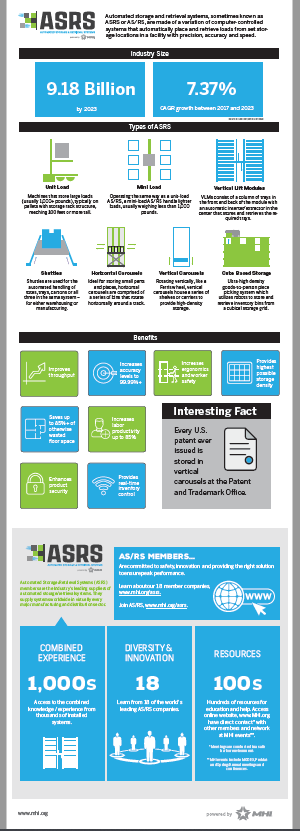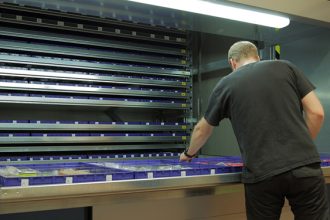ASRS as a Solution to the Labor Shortage

As the labor pool dwindles, automation like ASRS becomes the smart solution.
Roughly 11 million employees have exited the workforce over the past couple years, according to some estimates. In many cases, these employees said they were seeking safer, more interesting environments, while others wanted to avoid repetitive tasks that can lead to injury, fatigue, and boredom. Unfortunately, for warehouses, that often means trying to get work moved through the building with fewer people than ever. In many cases, however, automation represents a solution to the problem.
An automated storage and retrieval system (ASRS) is one of the best remedies for warehouses fighting the labor shortage. The chief reason in favor of ASRS is that the automated systems deliver items to workers, presenting them at a proper ergonomic height. This removes or reduces workers’ repetitive motions of stooping, reaching, or even climbing ladders, leaving employees feeling better physically at the end of a long shift.
 Another way that ASRS fits the bill lies in its potential to attract younger workers who grew up with screens in their hands. For these “device generations” of younger millennials and Gen Z, it’s more natural and intuitive for them to pick up cutting-edge technology than working in an old-school warehouse environment. Tools like ASRS and the software that it connects to are right in line with what younger workers know – it will better hold their interest and keep them from leaving their jobs.
Another way that ASRS fits the bill lies in its potential to attract younger workers who grew up with screens in their hands. For these “device generations” of younger millennials and Gen Z, it’s more natural and intuitive for them to pick up cutting-edge technology than working in an old-school warehouse environment. Tools like ASRS and the software that it connects to are right in line with what younger workers know – it will better hold their interest and keep them from leaving their jobs.
ASRS also serves the purpose of doing more with less, which, in this case, means fewer employees. If your facility is struggling to maintain a full workforce, installing an automation solution like ASRS – which doesn’t get tired, take breaks, or need to pause for a meal – can keep your productivity levels up while staffing numbers are down. This is particularly important as the demand for e-commerce explodes, and warehouses must keep up a rapid pace.
An increase in the demand for smaller parts/pieces picking across the board makes ASRS a strong solution to combat the labor shortage. Due to this demand, you’ll find the growth of ASRS solutions in a wide variety of industries. Automotive, manufacturing, electronics, retail, and pharmacy are all industries adopting ASRS.
Many companies like the idea of ASRS but worry about the cost. However, a one-time investment in the technology can reduce or remove many ongoing costs. These include the cost to recruit and train employees, paying salaries, healthcare, and more. As these costs rise with years of experience, the ASRS delivers a return on investment (ROI) quickly.
One example of cost savings shows the ROI of a car dealership’s parts department. The dealership discovered that the average pick time using standard shelving was 61 seconds for one employee to search for one item. The ASRS, by comparison, was able to deliver the part in just 15 seconds. Using this metric, the dealership determined it could achieve a 35 percent savings in labor productivity, reallocating 1.4 people from its parts department or increasing the department’s picking volume by 35 percent with the same number of staff.
If yesterday wasn’t the time to look at an ASRS solution, today’s the day.
Further Reading:
Using ASRS To Offset The Labor Shortage
For more information about the ASRS group:




